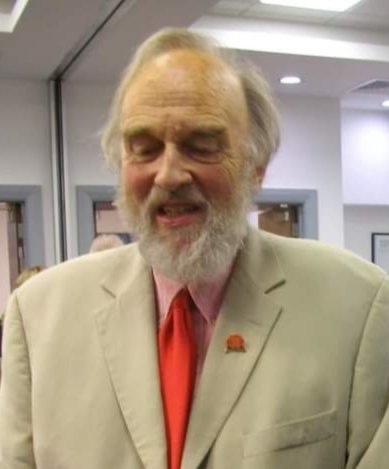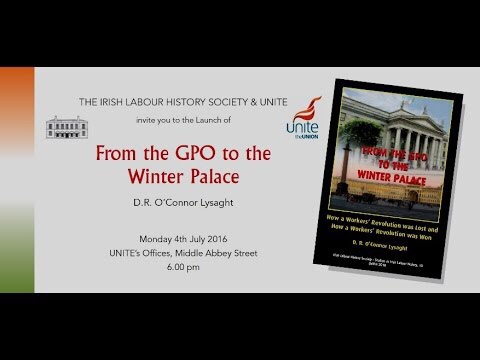
Rayner Lysaght Archive | Trotskyist Writers Index | ETOL Main Page
Published on the Tomás Ó Flatharta: Looking at Things from the Left Blog, 5 July 2021
Copied with thanks from the Website.
Transcribed & marked up by Einde O’Callaghan for the Encyclopaedia of Trotskyism On-Line (ETOL).

|
Most readers of this site probably know the sad news that Rayner Lysaght passed away on Friday, July 2, 2021. He was born in Llanishen, Cardiff, Wales, on January 30, 1941.
Here is a link to the death notice: RIP.ie Death Notice. People can add condolences, if they wish.
A wide range of people from the left and the workers’ movement have written generous personal tributes. A number of them are here at Cedar Lounge.
People in Dublin may wish to join friends and comrades lining the route holding banners and tributes aloft. I will be bringing a Starry Plough and Fourth International banner. People might like to assist.
Rayner Lysaght was a long-standing supporter of the Fourth International, a founder-member of its Irish Section – the Revolutionary Marxist Group, in 1971. Wikipedia: Revolutionary Marxist Group (Ireland).
The cremation ceremony starts at 2.00 p.m., so try to get to Glasnevin Cemetery at least 15 minutes before that time.
I’m very sad to write that my dear friend and comrade Rayner Daniel Lysaght passed away today at Beaumont hospital. Rayner was a lifelong revolutionary Marxist, historian and author, a Trotskyist and member of the Fourth International. He will be sadly missed by friends, family and comrades from around the world. I visited his wife Aine today in hospital and she is coping bravely with the news. Rayner wrote under the name D.R. O’Connor Lysaght and leaves behind a large literary legacy, beginning with The Republic of Ireland in 1971 and more recently a trade union history 100 Years of Liberty Hall.
He was always to be seen at political meetings and demonstrations. I first met Rayner in the late seventies and was in regular contact with him assisting him these last few months. Myself and Kate and Grainne will miss him dearly.
Funeral arrangements: leaving Stafford’s Funeral Home Maypark @ 1.30 p.m. Tuesday 6th arriving at Glasnevin crematorium for service at 2 p.m. It will be on rip and funeral can be viewed on webcam.”
When Anne Conway gave me the news on Friday last I was outside Grogan’s Pub in South William Street, a favourite haunt of many people from the left – including at that exact moment the Labour historian Donal Fallon sitting with the former political prisoner Nicky Kelly. I passed on the sad news and Donal pointed out, straight away, that in the 1960’s Rayner was a pioneer historian of the Irish workers’ revolutionary story – especially the Limerick Soviet of 1919.
Joe Harrington adds:
So sorry to hear the sad news. Rayner seems to have been around forever. First met him in Dublin in 1972 when I stayed with him and Aine (and a few other notorious and not so notorious characters) in the place that I think was known as Parnell Road, in Harold’s Cross. Much later in Limerick the link to Rayner was persistent. He looked to us in the Treaty City for sorting the practical aspects of producing the six or so editions of his The Story of the Limerick Soviet – aspects such as typing out his handwritten and long revised tracts of the narrative – on the old fashioned typewriter, typex and all. :) Every edition had to be launched and to succeed in putting a time limit on Rayner speeches, on those occasions, was never easy. As Pat O’Connor could tell and as Mary O’Donnell tells, there was always a story to tell after Rayner returned home. I think Rayner saw the Limerick Soviet as extremely important as a clearcut example, in so many ways, of how workers can change society and the lessons from that particular effort – the strike weapon, the organisation of a society without bosses (if only for a short while), the impinging national question, the international aspect and the bureaucrats and the clerics sellout. Apart from his other work, Rayner Lysaght’s labours on the Soviet has ensured that he has made a difference. But sure that’s what legends of the socialist movement do.
A Limerick Soviet Tribute: Twitter.com.
 From the GPO to the Winter Palace – produced with assistance from the UNITE Trade Union and the Irish Labour History Society |
Donal Fallon has written a highly recommended account of a famous Dublin event on March 8 1966 (International Women’s Day). “Notorious characters” from Rayner’s milieu decided the city of Dublin housed too many monuments honouring British imperialists. Liam Sutcliffe blew up Nelson’s Pillar.
 |
The Dubliners celebrated with this mocking ballad on YouTube – a rebellious spirit is captured beautifully by Ronnie Drew’s deadpan voice.
| For a hundred and fifty-seven years it stood up there in state |
Liam Sutcliffe, Rayner, the late Peter Graham and Máirín Keegan, and many others, were among the “notorious characters” who, in 1968–9, established a Defence Committee in the 26 County bit of Ireland. Some were also involved with Saor Éire. The North had erupted, following the famous Derry Civil Rights March of October 1968. Rayner once remarked that events like these were created by the parents of modern Irish Trotskyism – even though its children today might be embarrassed by some of the older generation’s antics!
A final note by Jim Monaghan
A polymath. (I remember many pleasant conversations on obscure footnotes in history, where he knew really interesting bits and pieces.) Born in South Wales. Was in the Irish Workers Group in the mid to late sixties with Gery Lawless, Paddy Healy, Eamonn McCann and Sean Matgamna. Very erudite. He was in the Irish section of the Fourth International from the earliest days to the end. Made a big contribution to Irish Left history. He explored, the first to do so, the Irish soviets during the War of Independence. He had a broad range of interests. I recall a lecture he gave in the Pearse Institute on James Joyce and Ulysses. He had trawled the daily Freeman’s Journal to check each and every contemporary reference. He contributed financially to the defence of Northern ghettos and went bail for people in political charges. He had his weaknesses, a tendency to get lost in footnotes. But always worth bearing with from the insights he had. I remember Paddy Healy telling me that while many of us would fall by the wayside, Rayner would hold to the path, selling a left-wing paper outside meetings. Rayner never lost the faith in a revolution in Ireland and across the world.
P.S. This is a good irreverent source: Splintered Sunrise: The Irish Workers Group, People’s Democracy and Early Irish Trotskyism
P.P.S. A good account of Rayner Lysaght’s funeral: Sráid Marx: Comrade Rayner Lysaght, 1941–2021
International Viewpoint Tribute Here: Rayner O’Connor Lyssght presente!
Deaglán de Bréadún wrote a fine obituary of Rayner Lysaght, published in the July 11 edition of the Sunday Independent: Rayner Lysaght: Leading activist and historian in the labour movement and a hugely influential figure in Ireland’s left wing political sphere.
I met Deaglán at Rayner’s funeral, and we trawled back to the 1970’s when we were all comrades in People’s Democracy and the Fourth International.
Here is an extract :
“Rayner Lysaght died after a prolonged illness on July 2 in Beaumont Hospital, Dublin, at the age of 80 years. He was a prominent activist and historian in the Irish labour movement and an intellectual forebear in many ways of the current array of far-left parties and elected politicians.
“His full name, which he preferred to use in his writings, was Daniel Rayner O’Connor Lysaght. He was born on January 30, 1941, in Llanishen, Cardiff, the eldest son of surgeon Arthur and Jacqueline Lysaght (née Heard).
“The family had roots in Limerick and Cork and used the spelling “Conner” in their name, but Rayner preferred “O’Connor”, based on his admiration for Feargus O’Connor (1796–1855), an Irish-born leader of the radical Chartist movement for political reform in Britain.”
The article is extremely well researched. I discussed one aspect with Deaglán yesterday – quoted above – which may not be quite right. I understand that Rayner was, in fact, a direct descendant the radical Chartist Feargus O’Connor.
 Mourners, Funeral of Rayner Lysaght, hold aloft banners of the Starry Plough and the Fourth International – 6 July 2021, Glasnevin Cemetery |
 Manus O’Riordan, Irish Labour History Society and SIPTU, and a comrade, held aloft a banner honouring Irish volunteers who fought against the Francoist forces in the Spanish Civil War. |
 Mourners at Rayner Lysaght’s funeral included Paul Murphy TD, Dublin South-West (People Before Profit, RISE Network) – third from the left. |
 A Starry Plough, flag of James Connolly’s Irish Citizen Army, which participated in Ireland’s revolutionary 1916 Easter Rising, covers the coffin of Rayner Lysaght. To the left of the hearse, the banner of the Fourth International. |
I’ve known Rayner since the late 1960s. We never became close friends but I had an unflagging affection for him. He wrote The Republic of Ireland when in-depth Irish marxist literature was rare. This frontrunning continued with his contribution to the pioneering Ireland: Divided Nation, Divided Class. He was an outstanding historian with an encylopedic knowledge. His writings and intellectual contribution will live on. A long shelf of crucial research, hard work and astute observation. He did much to make more of James Connolly’s writings available. He ensured that Mattie Merrigan would be properly remembered. He was a stalwart of the Irish Labour History Society. Rayner was among the first to put the militant working class back into the Irish Revolution. He always strived to keep anti-imperialism in the labour movement. Rayner was always an activist, involved in many issues in his own way. Rayner was utterly sincere. He was always pleasant and friendly. Not the easiest speaker to chair: never troublesome, just too much knowledge to impart. As we are now seeing, he was widely respected and widely liked. He has done the workers’ movement some service.
Rayner Lysaght Archive | Trotskyist Writers Index | ETOL Main Page
Last updated: 2 August 2021